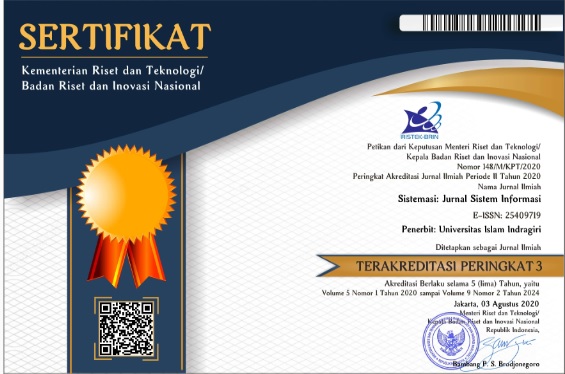Static Analysis-based Detection of Android Malware using Machine Learning Algorithms
Abstract
Keywords
Full Text:
PDFReferences
K. H. Thanoon, B. Mahmood, and M. M. A. Dabdawb, “The Effect of Malware’s Apis Relations on Software Security Design,” MINAR International Journal of Applied Sciences and Technology, Vol. 4, No. 1, pp. 1–157, Mar. 2022, doi: 10.47832/2717-8234.10.14.
S. Hasoon, T. Najim AL-Hadidi, and S. Omar Hasoon, “Software Defect Prediction using Extreme Gradient Boosting (XGBoost) with Optimization Hyperparameter,” Journal of Computer Sciences and Mathematics (RJCM), Vol. 18, No. 1, pp. 22–29, 2024, doi: 10.33899/CSMJ.2023.142739.108.
M. A. A. Al-Ameri, B. Mahmood, B. Ciylan, and A. Amged, “Unsupervised Forgery Detection of Documents: A Network-Inspired Approach,” Electronics (Switzerland), Vol. 12, No. 7, Apr. 2023, doi: 10.3390/electronics12071682.
A. Muzaffar, H. R. Hassen, H. Zantout, and M. A. Lones, “DroidDissector: A Static and Dynamic Analysis Tool for Android Malware Detection,” Aug. 2023, doi: 10.1007/978-3-031-40598-3_1.
C. S. Yadav et al., “Malware Analysis in IoT & Android Systems with Defensive Mechanism,” Electronics (Switzerland), Vol. 11, No. 15, Aug. 2022, doi: 10.3390/electronics11152354.
I. Almomani, M. Ahmed, and W. El-Shafai, “Android Malware Analysis in a Nutshell,” PLoS One, Vol. 17, No. 7 July, Jul. 2022, doi: 10.1371/journal.pone.0270647.
T. Tu, H. Zhang, B. Gong, D. Du, and Q. Wen, “Intelligent Analysis of Android Application Privacy Policy and Permission Consistency,” Artif Intell Rev, Vol. 57, No. 7, Jul. 2024, doi: 10.1007/s10462-024-10798-z.
Q. Wu, X. Zhu, and B. Liu, “A Survey of Android Malware Static Detection Technology based on Machine Learning,” 2021, Hindawi Limited. doi: 10.1155/2021/8896013.
Z. Muhammad, Z. Anwar, A. R. Javed, B. Saleem, S. Abbas, and T. R. Gadekallu, “Smartphone Security and Privacy: A Survey on APTs, Sensor-based Attacks, Side-Channel Attacks, Google Play Attacks, and Defenses,” Jun. 01, 2023, MDPI. doi: 10.3390/technologies11030076.
S. Arshad, M. Ali, A. Khan, and M. Ahmed, “Android Malware Detection & Protection: A Survey,” International Journal of Advanced Computer Science and Applications, Vol. 7, No. 2, 2016, doi: 10.14569/ijacsa.2016.070262.
P. Faruki, R. Bhan, V. Jain, S. Bhatia, N. El Madhoun, and R. Pamula, “A Survey and Evaluation of Android-based Malware Evasion Techniques and Detection Frameworks,” Jul. 01, 2023, Multidisciplinary Digital Publishing Institute (MDPI). doi: 10.3390/info14070374.
N. faith M Jameel and M. M. T. Jawhar, “A Survey on Malware Attacks Analysis and Detected,” International Research Journal of Innovations in Engineering and Technology, Vol. 07, No. 05, pp. 32–40, 2023, doi: 10.47001/irjiet/2023.705005.
N. A. Sultan, K. H. Thanoon, and O. A. Ibrahim, “Ethical Hacking Implementation for Lime Worm Ransomware Detection,” in Journal of Physics: Conference Series, Institute of Physics Publishing, May 2020. doi: 10.1088/1742-6596/1530/1/012078.
S. Sharma, Prachi, R. Chhikara, and K. Khanna, “A Novel Feature Selection Technique: Detection and Classification of Android Malware,” Egyptian Informatics Journal, Vol. 29, Mar. 2025, doi: 10.1016/j.eij.2025.100618.
K. Kılıç, İ. Atacak, and İ. A. Doğru, “FABLDroid: Malware Detection based on Hybrid Analysis with Factor Analysis and Broad Learning Methods for Android Applications,” Engineering Science and Technology, an International Journal, Vol. 62, Feb. 2025, doi: 10.1016/j.jestch.2024.101945.
J. Feng, L. Shen, Z. Chen, Y. Lei, and H. Li, “HGDetector: A Hybrid Android Malware Detection Method using Network Traffic and Function Call Graph,” Alexandria Engineering Journal, Vol. 114, pp. 30–45, Feb. 2025, doi: 10.1016/j.aej.2024.11.068.
W. Zhao, J. Wu, and Z. Meng, “AppPoet: Large Language Model based Android Malware Detection via Multi-View Prompt Engineering,” Apr. 2024, [Online]. Available: http://arxiv.org/abs/2404.18816
M. M. Alani and M. Alawida, “Behavioral Analysis of Android Riskware Families using Clustering and Explainable Machine Learning,” Big Data and Cognitive Computing, Vol. 8, No. 12, Dec. 2024, doi: 10.3390/bdcc8120171.
H. INAYOSHI Supervisor and S. Saito, “A Study on Taint Analysis with Runtime Data for Tracking Information Flows in Android Apps,” 2024.
M. F. Ismael and K. H. Thanoon, “Investigation Malware Analysis Depend on Reverse Engineering using IDAPro,” in 2022 8th International Conference on Contemporary Information Technology and Mathematics, ICCITM 2022, Institute of Electrical and Electronics Engineers Inc., 2022, pp. 227–231. doi: 10.1109/ICCITM56309.2022.10031698.
A. Ali and N. N. Saleem, “Classification of Software Systems Attributes based on Quality Factors using Linguistic Knowledge and Machine Learning: A review.,” Journal of Education and Science, Vol. 31, No. 3, pp. 66–90, Sep. 2022, doi: 10.33899/edusj.2022.134024.1245.
H. Ngirande, M. Muduva, R. Chiwariro, and A. Makate, “Detection and Analysis of Android Ransomware using the Support Vector Machines,” Int J Res Appl Sci Eng Technol, Vol. 12, No. 1, pp. 241–252, Jan. 2024, doi: 10.22214/ijraset.2024.57885.
H. Babbar, S. Rani, D. K. Sah, S. A. AlQahtani, and A. Kashif Bashir, “Detection of Android Malware in the Internet of Things Through the K-Nearest Neighbor Algorithm,” Sensors, Vol. 23, No. 16, Aug. 2023, doi: 10.3390/s23167256.
D. Aboshady, N. Ghannam, E. Elsayed, and L. Diab, “The Malware Detection Approach in the Design of Mobile Applications,” Symmetry (Basel), Vol. 14, No. 5, May 2022, doi: 10.3390/sym14050839.
P. Sivaprakash, M. Sankar, J. Vimala Ithayan, and C. Ramalingam, "Autonomous Android Malware Detection System based on Static Analysis," in Proc. 2024 Int. Conf. Integration Emerging Technol. Digital World (ICIETDW), Sep. 2024, pp. 1–6, doi: 10.1109/ICIETDW61607.2024.10939283.
J. M. Arif, M. F. A. Razak, S. Awang, S. R. T. Mat, N. S. N. Ismail, and A. Firdaus, “A Static Analysis Approach for Android Permission-based Malware Detection Systems,” PLoS One, Vol. 16, No. 9 September, Sep. 2021, doi: 10.1371/journal.pone.0257968.
R. Jusoh, A. Firdaus, S. Anwar, M. Z. Osman, M. F. Darmawan, and M. F. A. Razak, “Malware Detection using Static Analysis in Android: a review of FeCO (Features, Classification, and Obfuscation),” PeerJ Comput Sci, Vol. 7, pp. 1–54, 2021, doi: 10.7717/peerj-cs.522.
DOI: https://doi.org/10.32520/stmsi.v14i5.5498
Article Metrics
Abstract view : 1057 timesPDF - 116 times
Refbacks
- There are currently no refbacks.

This work is licensed under a Creative Commons Attribution-ShareAlike 4.0 International License.









